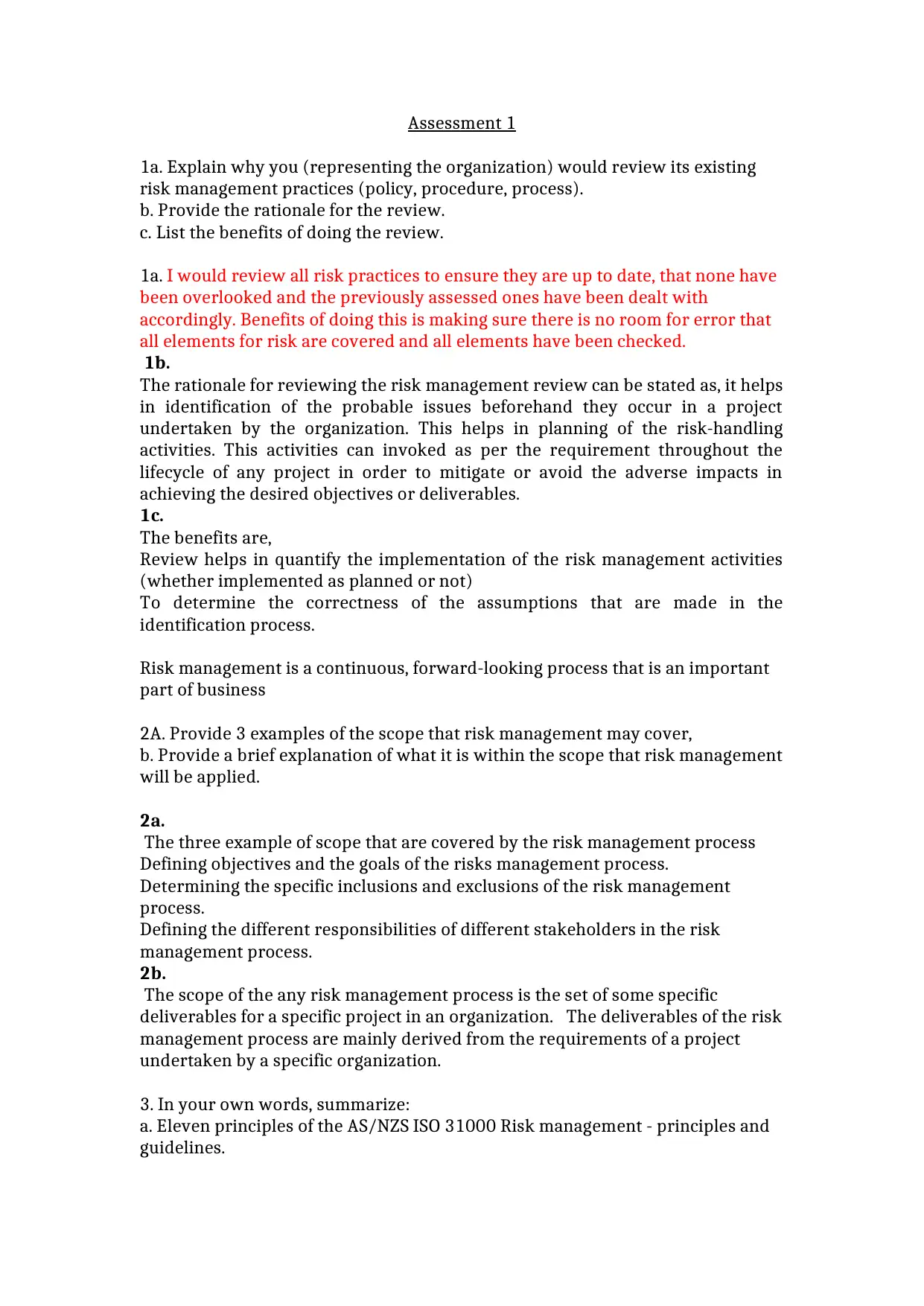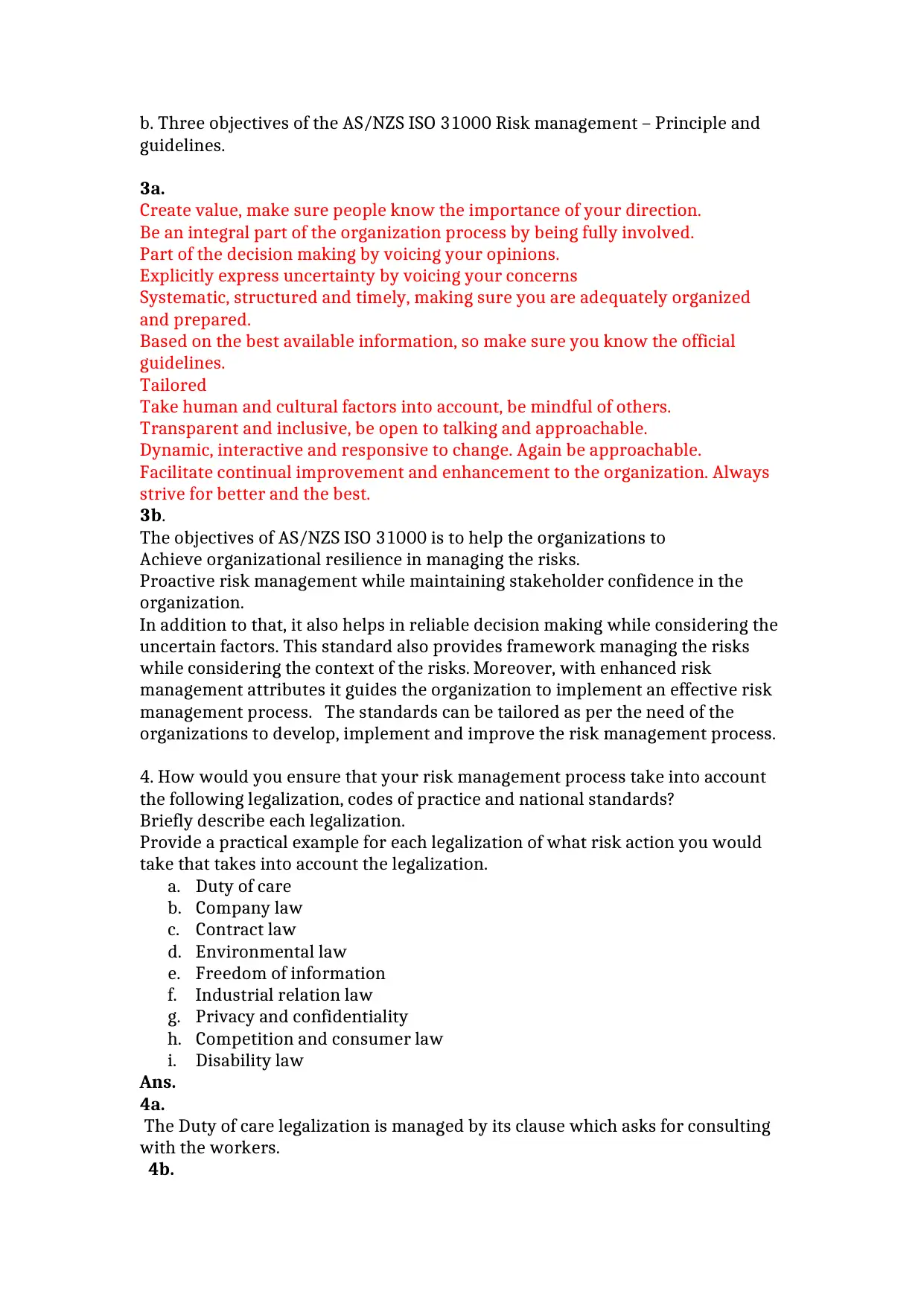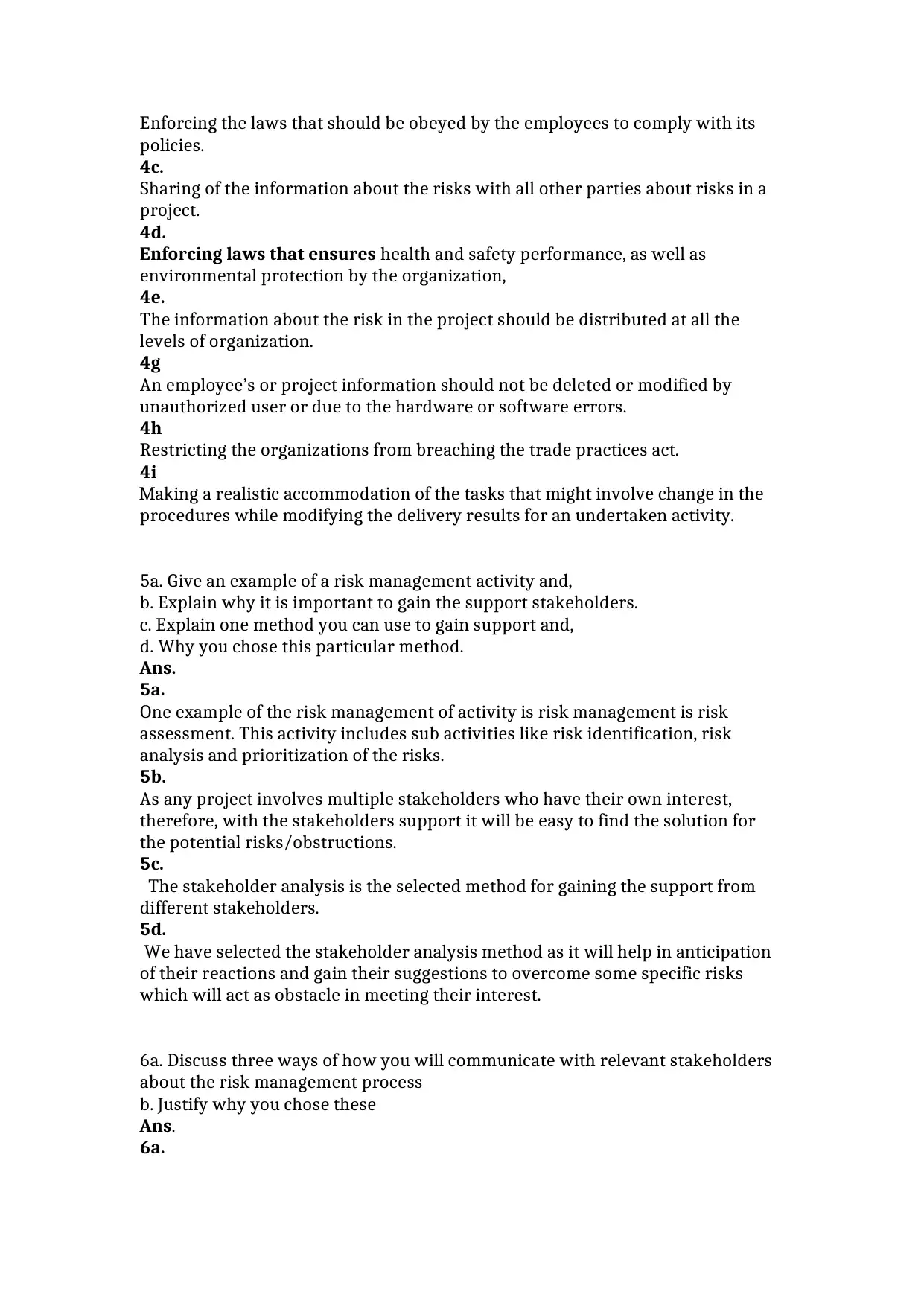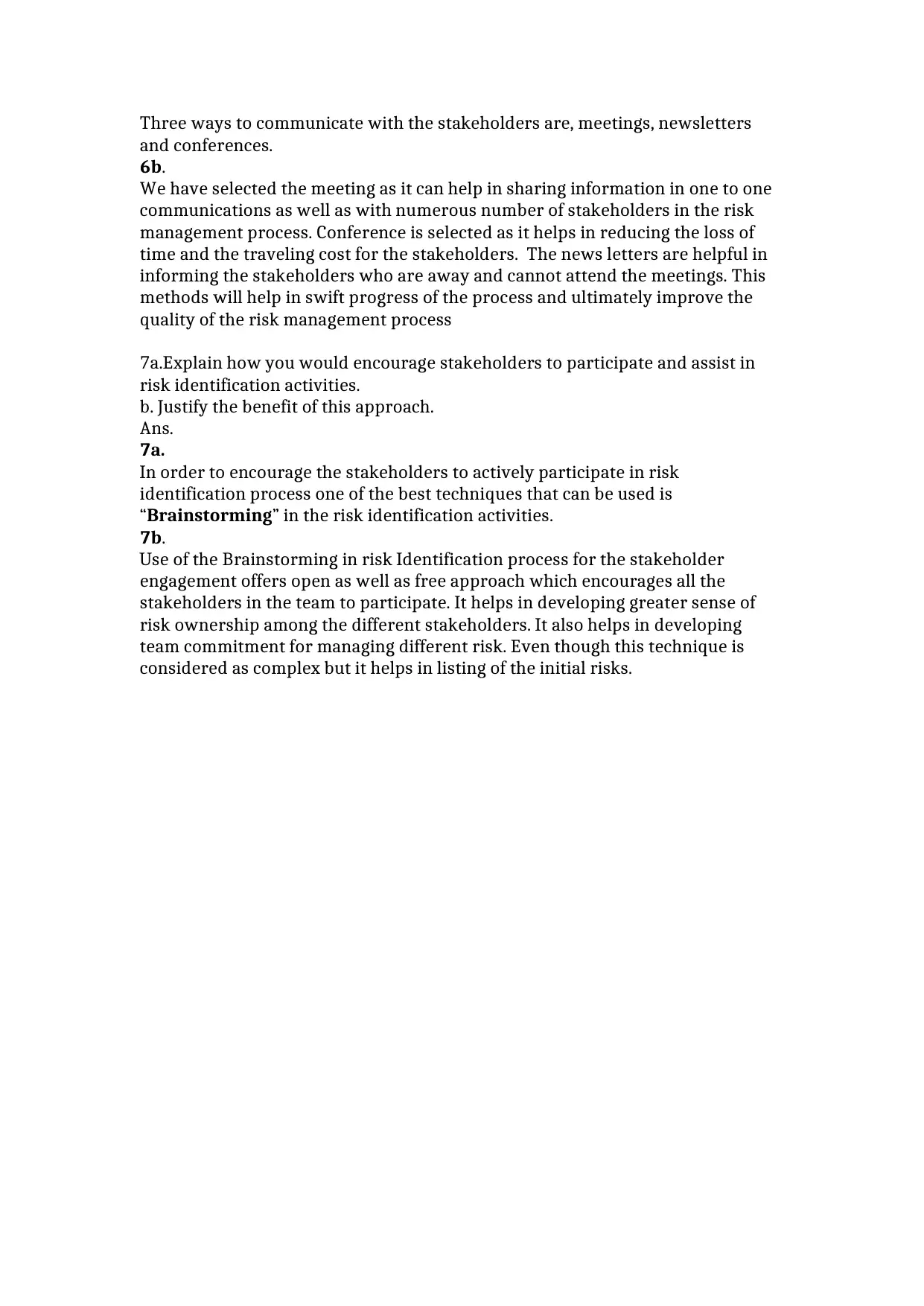Risk Management Practices: Review, Stakeholders and Legalization
VerifiedAdded on 2020/04/21
|4
|1333
|199
Homework Assignment
AI Summary
This assignment solution addresses various aspects of risk management, starting with the rationale for reviewing existing practices to ensure they are up-to-date and comprehensive. It explores the scope of risk management, providing examples and explanations. The solution summarizes the eleven principles and three objectives of the AS/NZS ISO 31000 standard, emphasizing value creation, integration, and proactive management. Furthermore, it details how to incorporate legalizations, codes of practice, and national standards into the risk management process, offering practical examples for each. The assignment also covers risk management activities like risk assessment, the importance of stakeholder support, and effective communication methods, including meetings, newsletters, and conferences. Finally, it discusses techniques to encourage stakeholder participation in risk identification, such as brainstorming, and explains the benefits of this approach. The assignment provides a comprehensive overview of risk management principles and practical applications.

Assessment 1
1a. Explain why you (representing the organization) would review its existing
risk management practices (policy, procedure, process).
b. Provide the rationale for the review.
c. List the benefits of doing the review.
1a. I would review all risk practices to ensure they are up to date, that none have
been overlooked and the previously assessed ones have been dealt with
accordingly. Benefits of doing this is making sure there is no room for error that
all elements for risk are covered and all elements have been checked.
1b.
The rationale for reviewing the risk management review can be stated as, it helps
in identification of the probable issues beforehand they occur in a project
undertaken by the organization. This helps in planning of the risk-handling
activities. This activities can invoked as per the requirement throughout the
lifecycle of any project in order to mitigate or avoid the adverse impacts in
achieving the desired objectives or deliverables.
1c.
The benefits are,
Review helps in quantify the implementation of the risk management activities
(whether implemented as planned or not)
To determine the correctness of the assumptions that are made in the
identification process.
Risk management is a continuous, forward-looking process that is an important
part of business
2A. Provide 3 examples of the scope that risk management may cover,
b. Provide a brief explanation of what it is within the scope that risk management
will be applied.
2a.
The three example of scope that are covered by the risk management process
Defining objectives and the goals of the risks management process.
Determining the specific inclusions and exclusions of the risk management
process.
Defining the different responsibilities of different stakeholders in the risk
management process.
2b.
The scope of the any risk management process is the set of some specific
deliverables for a specific project in an organization. The deliverables of the risk
management process are mainly derived from the requirements of a project
undertaken by a specific organization.
3. In your own words, summarize:
a. Eleven principles of the AS/NZS ISO 31000 Risk management - principles and
guidelines.
1a. Explain why you (representing the organization) would review its existing
risk management practices (policy, procedure, process).
b. Provide the rationale for the review.
c. List the benefits of doing the review.
1a. I would review all risk practices to ensure they are up to date, that none have
been overlooked and the previously assessed ones have been dealt with
accordingly. Benefits of doing this is making sure there is no room for error that
all elements for risk are covered and all elements have been checked.
1b.
The rationale for reviewing the risk management review can be stated as, it helps
in identification of the probable issues beforehand they occur in a project
undertaken by the organization. This helps in planning of the risk-handling
activities. This activities can invoked as per the requirement throughout the
lifecycle of any project in order to mitigate or avoid the adverse impacts in
achieving the desired objectives or deliverables.
1c.
The benefits are,
Review helps in quantify the implementation of the risk management activities
(whether implemented as planned or not)
To determine the correctness of the assumptions that are made in the
identification process.
Risk management is a continuous, forward-looking process that is an important
part of business
2A. Provide 3 examples of the scope that risk management may cover,
b. Provide a brief explanation of what it is within the scope that risk management
will be applied.
2a.
The three example of scope that are covered by the risk management process
Defining objectives and the goals of the risks management process.
Determining the specific inclusions and exclusions of the risk management
process.
Defining the different responsibilities of different stakeholders in the risk
management process.
2b.
The scope of the any risk management process is the set of some specific
deliverables for a specific project in an organization. The deliverables of the risk
management process are mainly derived from the requirements of a project
undertaken by a specific organization.
3. In your own words, summarize:
a. Eleven principles of the AS/NZS ISO 31000 Risk management - principles and
guidelines.
Paraphrase This Document
Need a fresh take? Get an instant paraphrase of this document with our AI Paraphraser

b. Three objectives of the AS/NZS ISO 31000 Risk management – Principle and
guidelines.
3a.
Create value, make sure people know the importance of your direction.
Be an integral part of the organization process by being fully involved.
Part of the decision making by voicing your opinions.
Explicitly express uncertainty by voicing your concerns
Systematic, structured and timely, making sure you are adequately organized
and prepared.
Based on the best available information, so make sure you know the official
guidelines.
Tailored
Take human and cultural factors into account, be mindful of others.
Transparent and inclusive, be open to talking and approachable.
Dynamic, interactive and responsive to change. Again be approachable.
Facilitate continual improvement and enhancement to the organization. Always
strive for better and the best.
3b.
The objectives of AS/NZS ISO 31000 is to help the organizations to
Achieve organizational resilience in managing the risks.
Proactive risk management while maintaining stakeholder confidence in the
organization.
In addition to that, it also helps in reliable decision making while considering the
uncertain factors. This standard also provides framework managing the risks
while considering the context of the risks. Moreover, with enhanced risk
management attributes it guides the organization to implement an effective risk
management process. The standards can be tailored as per the need of the
organizations to develop, implement and improve the risk management process.
4. How would you ensure that your risk management process take into account
the following legalization, codes of practice and national standards?
Briefly describe each legalization.
Provide a practical example for each legalization of what risk action you would
take that takes into account the legalization.
a. Duty of care
b. Company law
c. Contract law
d. Environmental law
e. Freedom of information
f. Industrial relation law
g. Privacy and confidentiality
h. Competition and consumer law
i. Disability law
Ans.
4a.
The Duty of care legalization is managed by its clause which asks for consulting
with the workers.
4b.
guidelines.
3a.
Create value, make sure people know the importance of your direction.
Be an integral part of the organization process by being fully involved.
Part of the decision making by voicing your opinions.
Explicitly express uncertainty by voicing your concerns
Systematic, structured and timely, making sure you are adequately organized
and prepared.
Based on the best available information, so make sure you know the official
guidelines.
Tailored
Take human and cultural factors into account, be mindful of others.
Transparent and inclusive, be open to talking and approachable.
Dynamic, interactive and responsive to change. Again be approachable.
Facilitate continual improvement and enhancement to the organization. Always
strive for better and the best.
3b.
The objectives of AS/NZS ISO 31000 is to help the organizations to
Achieve organizational resilience in managing the risks.
Proactive risk management while maintaining stakeholder confidence in the
organization.
In addition to that, it also helps in reliable decision making while considering the
uncertain factors. This standard also provides framework managing the risks
while considering the context of the risks. Moreover, with enhanced risk
management attributes it guides the organization to implement an effective risk
management process. The standards can be tailored as per the need of the
organizations to develop, implement and improve the risk management process.
4. How would you ensure that your risk management process take into account
the following legalization, codes of practice and national standards?
Briefly describe each legalization.
Provide a practical example for each legalization of what risk action you would
take that takes into account the legalization.
a. Duty of care
b. Company law
c. Contract law
d. Environmental law
e. Freedom of information
f. Industrial relation law
g. Privacy and confidentiality
h. Competition and consumer law
i. Disability law
Ans.
4a.
The Duty of care legalization is managed by its clause which asks for consulting
with the workers.
4b.

Enforcing the laws that should be obeyed by the employees to comply with its
policies.
4c.
Sharing of the information about the risks with all other parties about risks in a
project.
4d.
Enforcing laws that ensures health and safety performance, as well as
environmental protection by the organization,
4e.
The information about the risk in the project should be distributed at all the
levels of organization.
4g
An employee’s or project information should not be deleted or modified by
unauthorized user or due to the hardware or software errors.
4h
Restricting the organizations from breaching the trade practices act.
4i
Making a realistic accommodation of the tasks that might involve change in the
procedures while modifying the delivery results for an undertaken activity.
5a. Give an example of a risk management activity and,
b. Explain why it is important to gain the support stakeholders.
c. Explain one method you can use to gain support and,
d. Why you chose this particular method.
Ans.
5a.
One example of the risk management of activity is risk management is risk
assessment. This activity includes sub activities like risk identification, risk
analysis and prioritization of the risks.
5b.
As any project involves multiple stakeholders who have their own interest,
therefore, with the stakeholders support it will be easy to find the solution for
the potential risks/obstructions.
5c.
The stakeholder analysis is the selected method for gaining the support from
different stakeholders.
5d.
We have selected the stakeholder analysis method as it will help in anticipation
of their reactions and gain their suggestions to overcome some specific risks
which will act as obstacle in meeting their interest.
6a. Discuss three ways of how you will communicate with relevant stakeholders
about the risk management process
b. Justify why you chose these
Ans.
6a.
policies.
4c.
Sharing of the information about the risks with all other parties about risks in a
project.
4d.
Enforcing laws that ensures health and safety performance, as well as
environmental protection by the organization,
4e.
The information about the risk in the project should be distributed at all the
levels of organization.
4g
An employee’s or project information should not be deleted or modified by
unauthorized user or due to the hardware or software errors.
4h
Restricting the organizations from breaching the trade practices act.
4i
Making a realistic accommodation of the tasks that might involve change in the
procedures while modifying the delivery results for an undertaken activity.
5a. Give an example of a risk management activity and,
b. Explain why it is important to gain the support stakeholders.
c. Explain one method you can use to gain support and,
d. Why you chose this particular method.
Ans.
5a.
One example of the risk management of activity is risk management is risk
assessment. This activity includes sub activities like risk identification, risk
analysis and prioritization of the risks.
5b.
As any project involves multiple stakeholders who have their own interest,
therefore, with the stakeholders support it will be easy to find the solution for
the potential risks/obstructions.
5c.
The stakeholder analysis is the selected method for gaining the support from
different stakeholders.
5d.
We have selected the stakeholder analysis method as it will help in anticipation
of their reactions and gain their suggestions to overcome some specific risks
which will act as obstacle in meeting their interest.
6a. Discuss three ways of how you will communicate with relevant stakeholders
about the risk management process
b. Justify why you chose these
Ans.
6a.
⊘ This is a preview!⊘
Do you want full access?
Subscribe today to unlock all pages.

Trusted by 1+ million students worldwide

Three ways to communicate with the stakeholders are, meetings, newsletters
and conferences.
6b.
We have selected the meeting as it can help in sharing information in one to one
communications as well as with numerous number of stakeholders in the risk
management process. Conference is selected as it helps in reducing the loss of
time and the traveling cost for the stakeholders. The news letters are helpful in
informing the stakeholders who are away and cannot attend the meetings. This
methods will help in swift progress of the process and ultimately improve the
quality of the risk management process
7a.Explain how you would encourage stakeholders to participate and assist in
risk identification activities.
b. Justify the benefit of this approach.
Ans.
7a.
In order to encourage the stakeholders to actively participate in risk
identification process one of the best techniques that can be used is
“Brainstorming” in the risk identification activities.
7b.
Use of the Brainstorming in risk Identification process for the stakeholder
engagement offers open as well as free approach which encourages all the
stakeholders in the team to participate. It helps in developing greater sense of
risk ownership among the different stakeholders. It also helps in developing
team commitment for managing different risk. Even though this technique is
considered as complex but it helps in listing of the initial risks.
and conferences.
6b.
We have selected the meeting as it can help in sharing information in one to one
communications as well as with numerous number of stakeholders in the risk
management process. Conference is selected as it helps in reducing the loss of
time and the traveling cost for the stakeholders. The news letters are helpful in
informing the stakeholders who are away and cannot attend the meetings. This
methods will help in swift progress of the process and ultimately improve the
quality of the risk management process
7a.Explain how you would encourage stakeholders to participate and assist in
risk identification activities.
b. Justify the benefit of this approach.
Ans.
7a.
In order to encourage the stakeholders to actively participate in risk
identification process one of the best techniques that can be used is
“Brainstorming” in the risk identification activities.
7b.
Use of the Brainstorming in risk Identification process for the stakeholder
engagement offers open as well as free approach which encourages all the
stakeholders in the team to participate. It helps in developing greater sense of
risk ownership among the different stakeholders. It also helps in developing
team commitment for managing different risk. Even though this technique is
considered as complex but it helps in listing of the initial risks.
1 out of 4
Related Documents
Your All-in-One AI-Powered Toolkit for Academic Success.
+13062052269
info@desklib.com
Available 24*7 on WhatsApp / Email
![[object Object]](/_next/static/media/star-bottom.7253800d.svg)
Unlock your academic potential
Copyright © 2020–2025 A2Z Services. All Rights Reserved. Developed and managed by ZUCOL.




